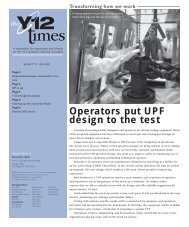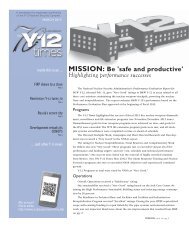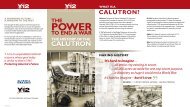A Biography of Dr. John M. Googin - Y-12 National Security ...
A Biography of Dr. John M. Googin - Y-12 National Security ...
A Biography of Dr. John M. Googin - Y-12 National Security ...
You also want an ePaper? Increase the reach of your titles
YUMPU automatically turns print PDFs into web optimized ePapers that Google loves.
FYI<br />
It was interesting to try to do the measurements<br />
without a good hood and without the trouble <strong>of</strong><br />
using the handy gas mask. It should be noted that<br />
there was no air cooling anywhere in the building,<br />
but some ventilation through the window in the<br />
summer time. It was recommended that the simple<br />
titration be done in the process area that generated<br />
the phosgene and had special ventilation, rather than<br />
in the<br />
Bulk Treatment laboratory that had little ventilation<br />
and hood space.<br />
Even though the phosgene was made by the ton,<br />
few were hurt. Unfortunately, one maintenance man<br />
was killed. It was one <strong>of</strong> these cases where work was<br />
to be done on a pipe line that was “empty” as defined<br />
by the safety work permit, but that was really<br />
full <strong>of</strong> the carbon tetrachloride and phosgene solution<br />
when it was opened.<br />
There was some air cooling in 1944 in 9203. Y-<strong>12</strong><br />
was doing enriched-uranium purification with the<br />
diethyl-ether solvent extraction <strong>of</strong> the nitrate<br />
method, and since this ether boils at 35 C (95 F) and<br />
the room temperature in the summer could get<br />
higher than that, some cooling had to be supplied,<br />
making that a good place to work or visit in summer<br />
if you liked the smell <strong>of</strong> ethyl ether. Some <strong>of</strong> the first<br />
<strong>of</strong> the highly enriched uranium for Los Alamos was<br />
seen there in pure nitrate solution form in the early<br />
summer <strong>of</strong> 1944.<br />
All <strong>of</strong> the electrical fixtures in the ether area had<br />
to be <strong>of</strong> the explosion- pro<strong>of</strong> kind, including the<br />
lights, so the area had a worrisome appearance.<br />
There never was a serious fire, even though some<br />
ether dripped from a pipe leak outside the protected<br />
FYI 46<br />
area onto a hot muffle furnace as it went from one<br />
area to another. There were cases <strong>of</strong> small ether fires<br />
where the flame from a Bunsen burner went from<br />
one lab bench to another, following ether vapor<br />
across a floor.<br />
There was that weekly progress report to get<br />
out, and there were the design data deadlines for the<br />
9207 complex to reach. Sometimes this pressure<br />
caused some really extended work times. The longest<br />
remembered was a work period <strong>of</strong> forty-eight hours<br />
in a row, to get data needed for decisions on the<br />
details <strong>of</strong> the new peroxide precipitation and calcination<br />
for the simplification <strong>of</strong> the flow diagram in the<br />
Bulk Treatment process. One must admit that the last<br />
few hours (after 36 hours) were not too productive.<br />
There were extensive experiments on better<br />
ways to do the chlorination <strong>of</strong> uranium trioxide to<br />
uranium tetrachloride, by the Process Improvement<br />
group and outside contractors. Some <strong>of</strong> the experiments<br />
were done in the production area. The rotating-nickel-drum<br />
batch reactor for vapor phase<br />
chlorination (developed by the Harshaw Chemical<br />
Co.) was adopted as the standard by the Production<br />
Department to replace the liquid phase process, but<br />
this was a batch process still. It was better in the<br />
sense that it produced the tetrachloride instead <strong>of</strong><br />
the pentachloride that was the primary product <strong>of</strong><br />
the high-pressure liquid carbon tetrachloride process,<br />
and the decomposition and sublimation steps<br />
were avoided if the oxide feed was pure enough. A<br />
continuous vapor-phase chlorination <strong>of</strong> a dancing bed<br />
moved by vibrators was installed on an experimental<br />
basis in 9202. It was interesting, noisy, but difficult to<br />
operate.








